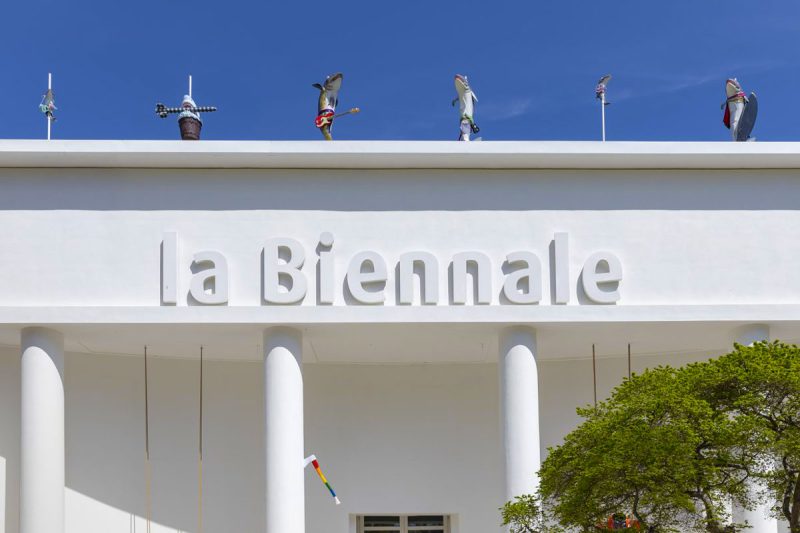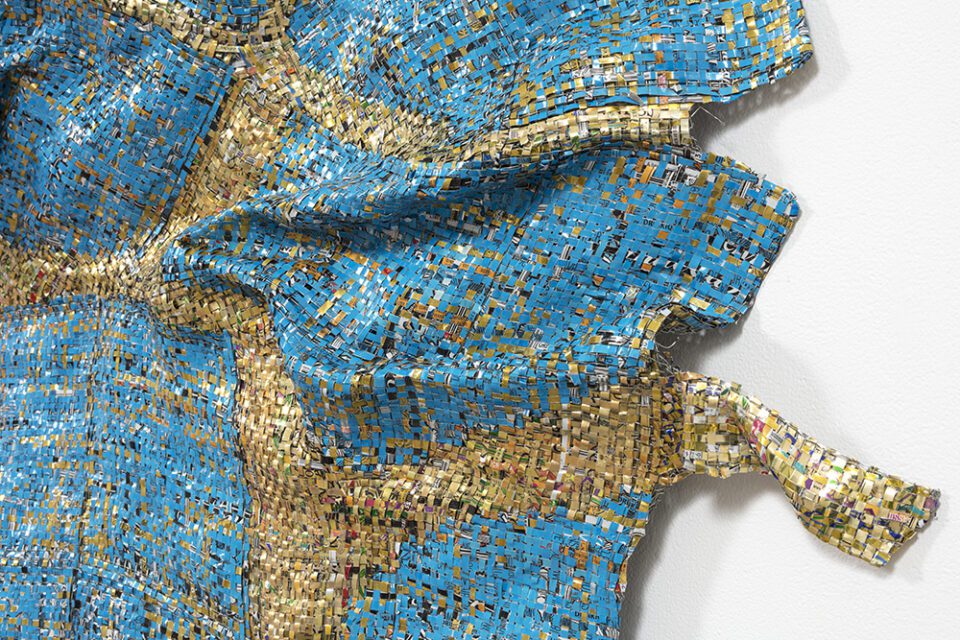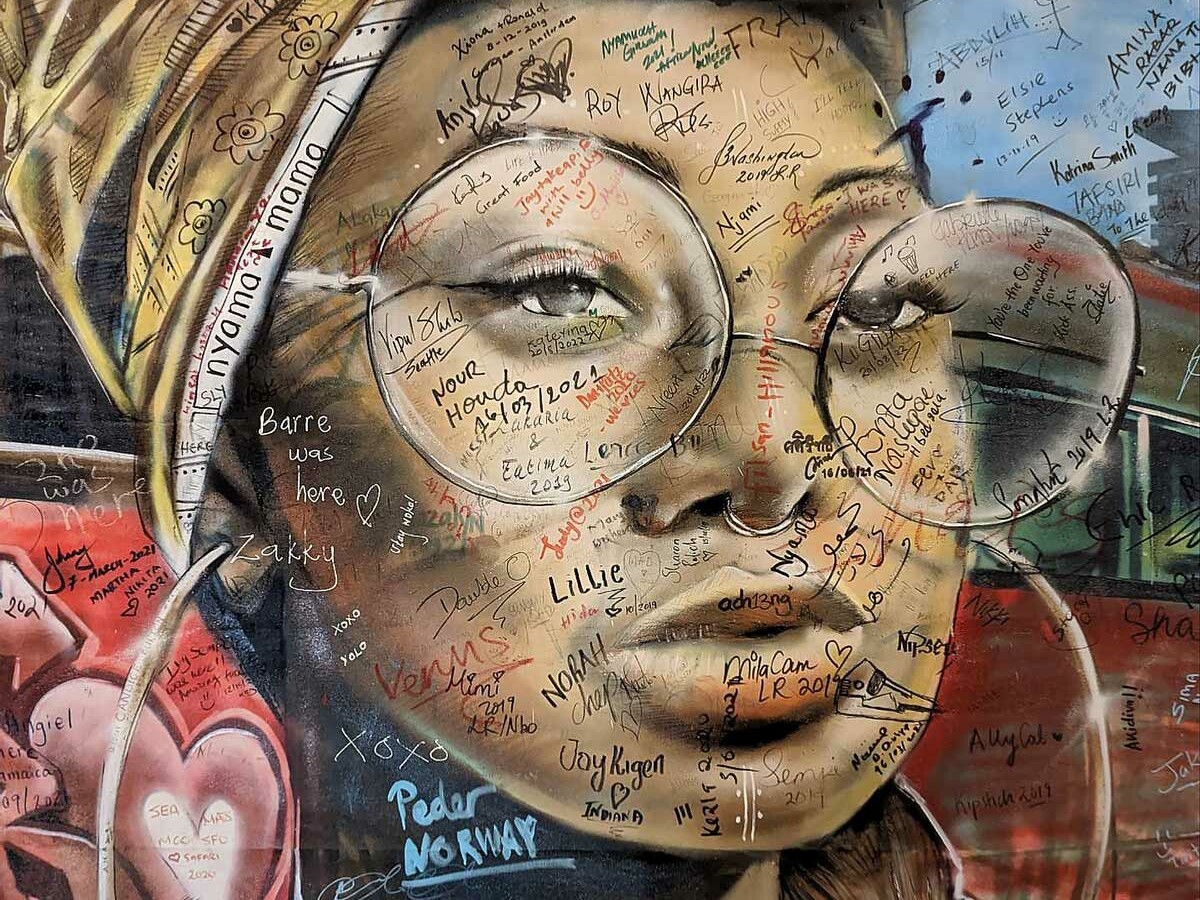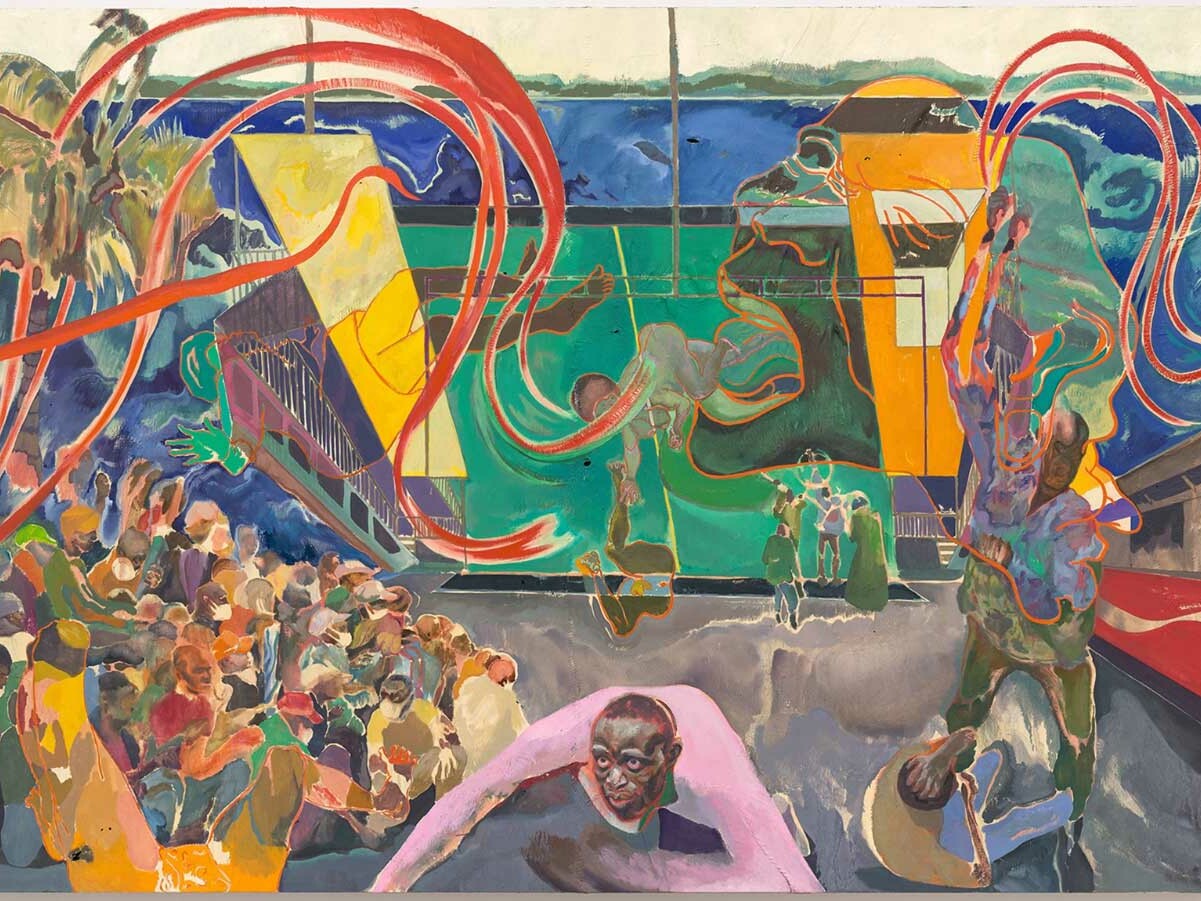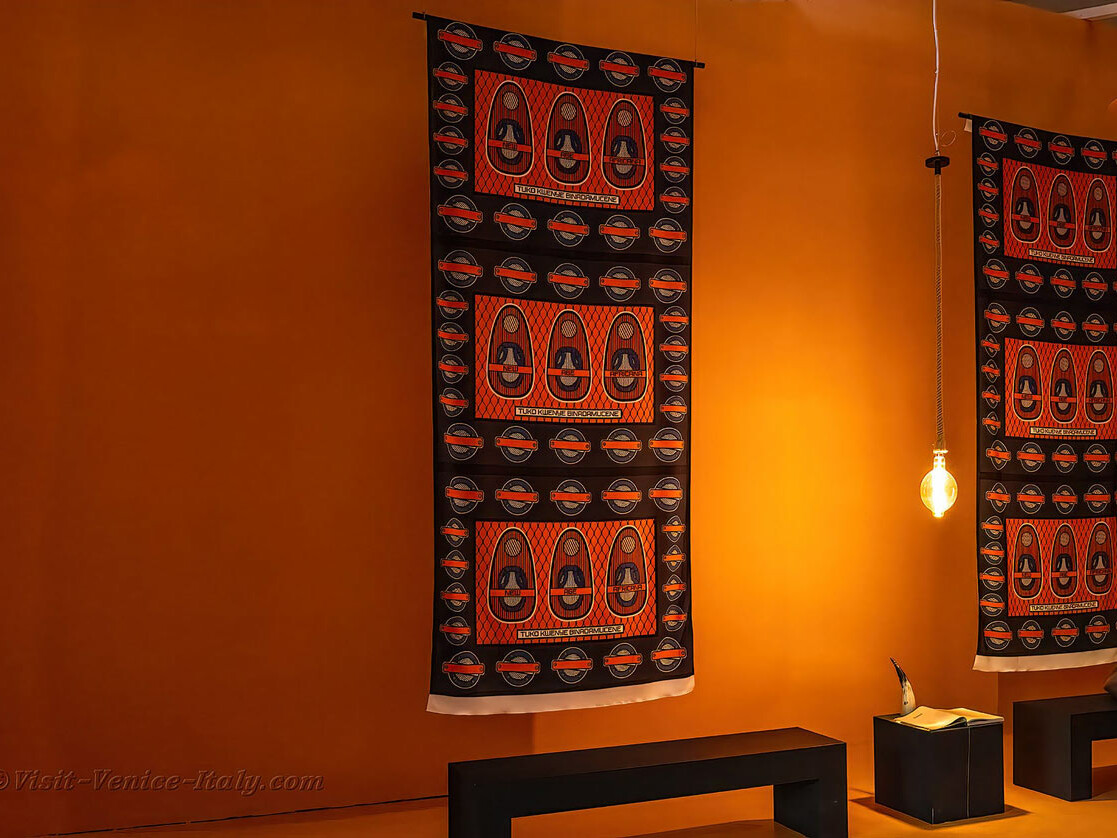After a 3-years hiatus, the Venice Art Biennale returned in 2022 and has been underway since April. Organized by the Biennale Foundation, the international art exhibition was held for the first time in 1895. It is one of the most important art events in the world attended by more than 500,000 people. The Biennale exhibitions include the Art Biennale, the Architecture Biennale, the Cinema Biennale, the Dance Biennale, the Music Biennale, and the Theatre Biennale. Of the six, the Art Biennale, the Architecture Biennale, and the Cinema Biennale are the most popular exhibitions.
History of Kenya and the Venice Biennale
Kenya’s first pavilion at the Art Biennale was commissioned and curated in 2013. It was marred by a lot of controversy surrounding the choice of artists representing Kenya. The exhibition was an abysmal selection of roadside art by two Italian curators shuffled into the so-called Kenyan Pavilion.
Kenya Venice Art Biennale Pavilion 2015
In 2015, the Kenya pavilion was mostly comprised of Italian and Chinese artists again. Of the 7 artists at the Kenyan pavilion, five were Chinese, one was a Kenyan-born artist living in Switzerland and the other was a 72-year-old Italian-born painter, sculptor and real estate magnate who has lived in the Kenyan coastal town of Malindi for nearly a half a century. The pavilion exhibitors had been selected by the same Italian commissioner who had selected exhibitors for Kenya’s pavilion at the previous 2013 Art Biennale. Speaking to the Guardian, the Italian commissioner Paola Poponi defended her choice of artists by saying “talking about art from another part of the world could be useful for Kenya in creating its own artistic identity”. Poponi added that art should not be constrained by geography. Few Kenyan artists were swayed by her empty words.
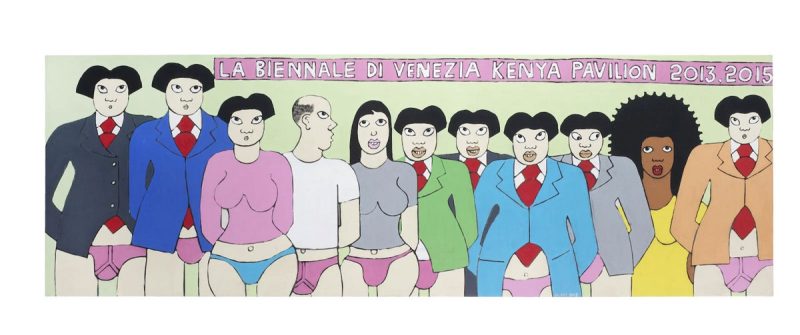
Mystifyingly titled “Reflective Nature: a New Primary Enchanting Sensitivity,” the 2015 exhibition was split over two locations: the space on the island of San Servolo was entirely devoted to a special project by the Italo-Brazilian artist Cesar Meneghetti, while the main site, at the Caserma Cornoldi, had a total of eight Chinese artists, one Italian and just two Kenyans.
The catalogue did little to justify what was clearly a blatant marginalization of Kenyan artists, with the Italian Poponi opting to wax lyrical about the beauty of “nature” in painfully reductive and primitivist terms instead: “this is Kenya, where Nature IS.”
In one room was the Italian artist Armando Tanzini’s crass “tribal” artefacts. His exhibition included a nude, supine sculpture of an African woman, carved out of wood, while the main courtyard space was dominated by garish flower pieces by Feng Zhengjie and a metallic orb by Chen Wenling. The rest of the exhibition included an incoherent assortment of Chinese paintings and several other installations that had no artistic connection with Kenya whatsoever.
Read: Why Are Chinese Artists Representing Kenya At The Venice Biennale?
Mounting Pressure
Due to mounting public pressure, the government was brought to the table to organize a more inclusive and representative pavilion for Kenya at the 2017 Art Biennale. The government pledged to support the initiative. Jimmy Ogonga was tapped as the curator of the Kenya pavilion determined to correct the previous record and curate an exhibition that showcased work from Kenyan artists which spoke to the direct context of the social and political issues Kenyans face.
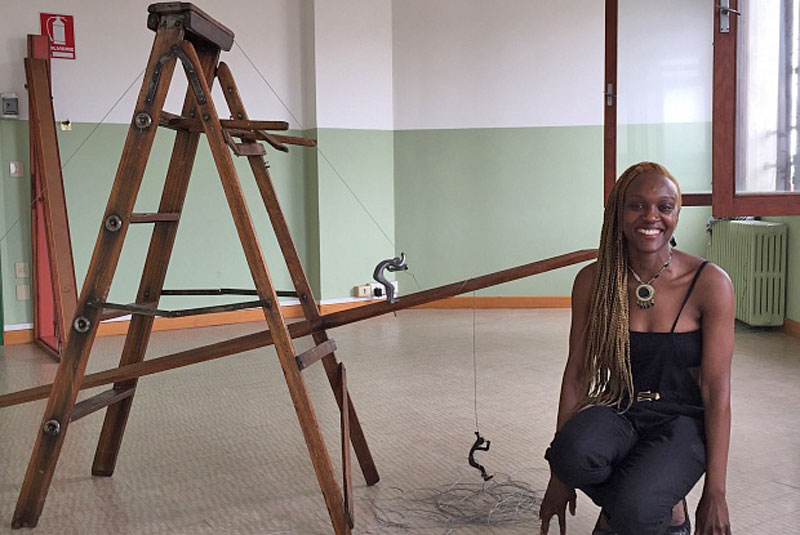
However, the agreement by the government to offer support for the 2017 Biennale was not honored. At the last minute, pavilion curator Jimmy Ogonga had to embark on a frantic fundraising mission. Despite not receiving the money that had been promised, pavilion organizers managed to pull off a miracle and put up exhibitions at the Art Biennale. Exhibiting at the Kenya pavilion were Arlene Wandera, Mwangi Hutter, Paul Onditi and Peterson Kamwathi. Speaking with ArtNewspaper, Ogonga remarked “It may not be the grandest exhibition, but it is ours.”
Kenya did not participate in the 2019 Biennale.
Venice Architecture Biennale Exhibition
In 2021, Kenya featured for the first time in the Venice Architecture Biennale Exhibition. Kenyan Firm Cave Bureau presented The Anthropocene Museum, “Obsidian Rain”, an installation in the dome of the Central Pavilion in the Giardini, presented as part of the As One Planet section curated by Sarkis. It was a post-colonial architectural reading, representation and proposal to critique the anthropocene era.
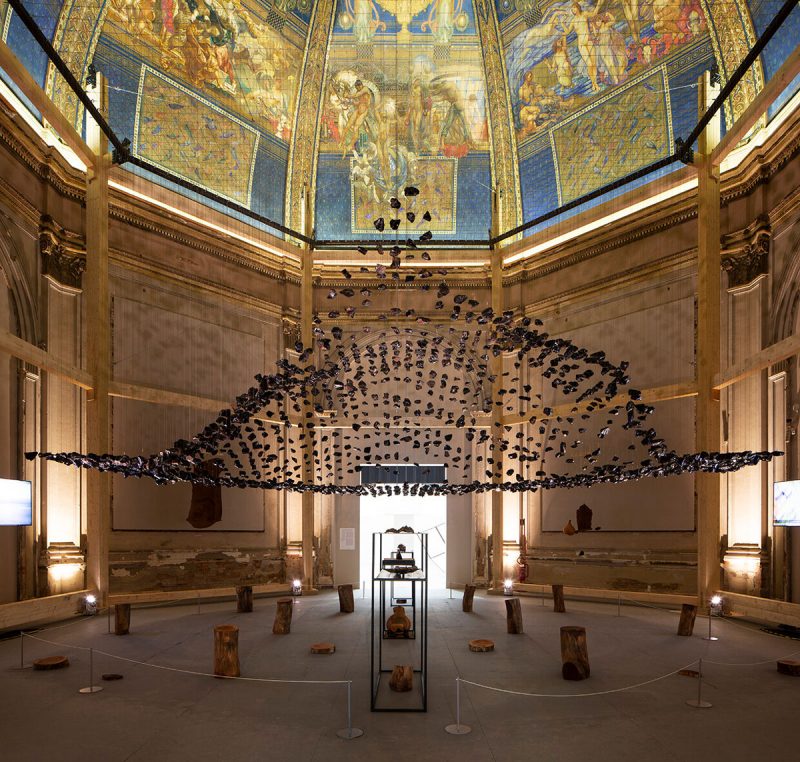
The installation comprised 1600 obsidian stones sourced from the Great Rift Valley hanging at precise heights from a timber and net structure to replicate a section of the roof of the Mbai Caves. The stones reference mankind’s earliest raw material, which was used to create stone tools. Cave Bureau was founded in 2014 by architects Kabage Karanja and Stella Mutegi.
Why Participation in the Venice Biennale is Important
Some might wonder why the Venice Biennale Exhibitions are important. There are several reasons, the first being that the Biennale is the largest contemporary art event in the world. The Venice Biennale is to the art world what the Olympics are to sports. Every odd year, more than half a million culture lovers flock Venice for the Biennale.
Here, artists mingle with curators, collectors and directors of museums from across the world. Showcasing your work at the Venice Biennale is an honor bestowed only to the cream of the artistry crop. It not only provides a platform for nations to showcase the best their artists have to offer but also creates a potent breeding ground for innovative ideas to be born and shared.
Democratized Awarding
Every artist at the Venice Biennale strives to create the most interesting exhibitions for their pavilions. The prizes awarded cannot be won by pleading or extravagant budgets. Democracy rules at the Biennale. Which is part of the attraction. Anyone can emerge winner, as long as they apply themselves in their work. In 2013 Angola won the award for best pavilion. In 2015, the honor fell on Armenia. Participation is not cheap. A pavilion could cost between $300,000 and $500,000. Due to the high costs, most artists need help to attend. This role is usually played by arts organizations and government institutions.
2022 Biennale
This year, the government provided support for the successful curation of Kenya’s Art Biennale pavilion. Kenya’s Cabinet Secretary for Sports, Culture and Heritage Amina Mohamed attended the Biennale opening in a show of government support. An official ‘Pavilion of Kenya at La Biennale Di Venezia’ website was also launched with details about the artists and the curator of the 2022 Kenya pavilion.
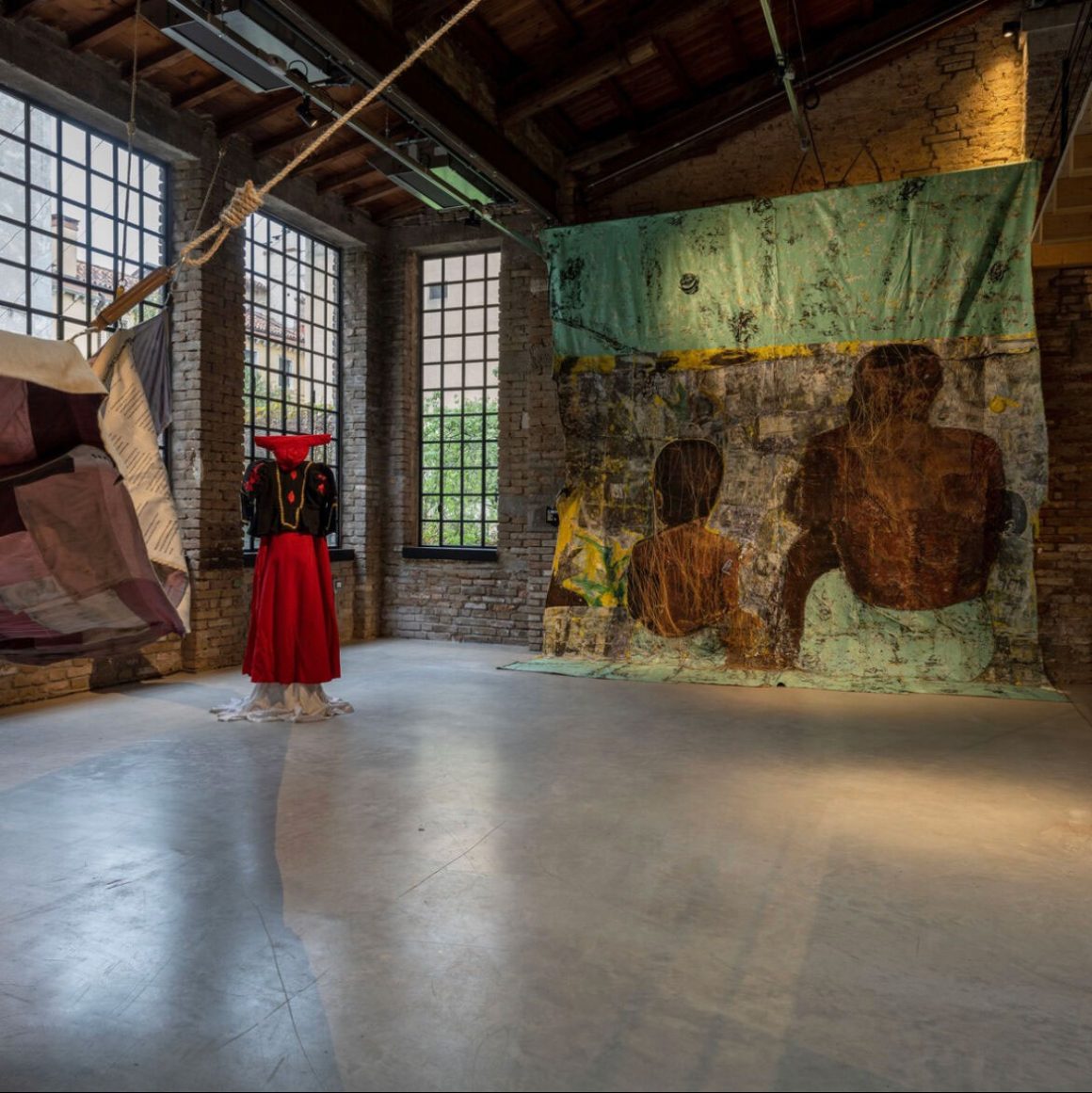
The Kenya pavilion at this year’s Art Biennale is curated by Jimmy Ogonga. The exhibition features the work of Kenyan artists Dickens Otieno, Syowia Kyambi, Kaloki Nyamai and Wanja Kimani.
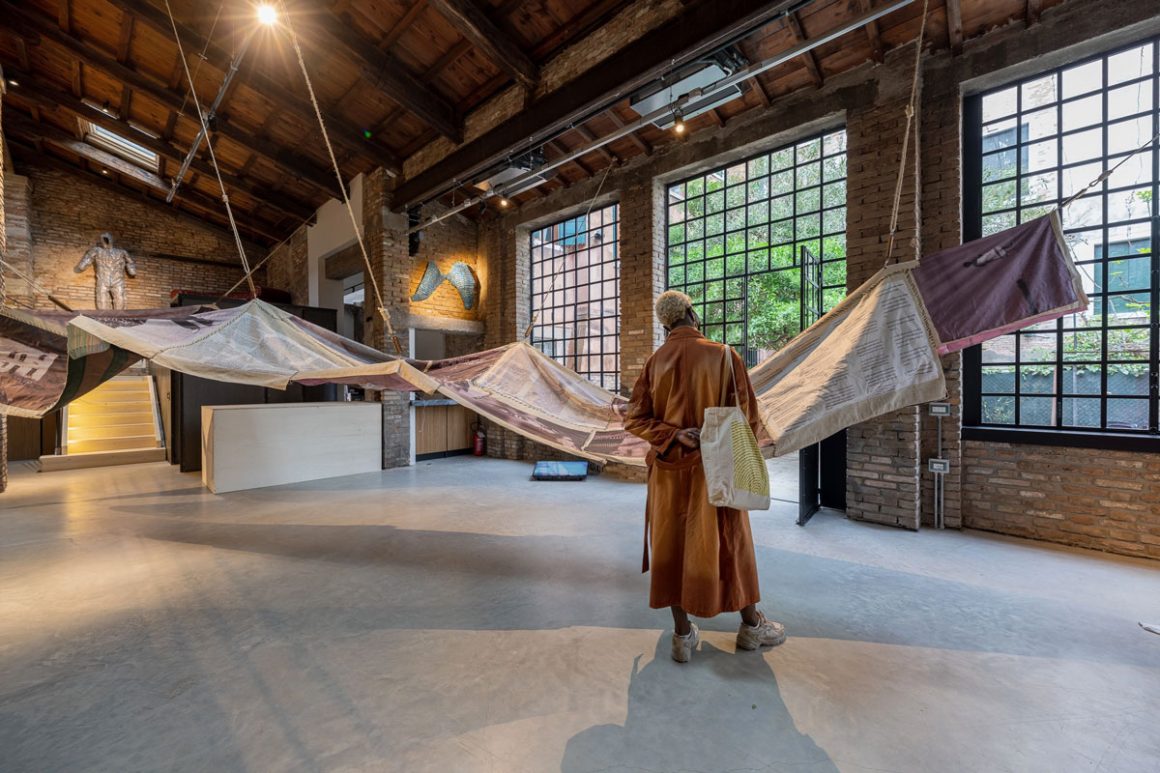
Exercises in Conversation
The exhibition explores the relationships and dynamics between participants in a conversation, the interchanging roles of both talker and listener, and how this complex relationship affects, influences and occupies the space of a story, of history and of pedagogy.
The individual practices of the artists are strongly rooted in their respective identities and stories, approaching their art making through distinguished uses of language and forms, pushing conceptual and material boundaries and in the process, responding to the kaleidoscopic nature in which Kenyan contemporaneity continues to be conceived.
Kenyan Artists Exhibiting at the 2022 Venice Biennale
Kenya’s 2022 pavilion at the Biennale will have 4 artists showcasing their work.
Dickens Otieno
Otieno is a Kenyan visual artist whose work features sculptures and tapestries made of woven strips derived from discarded aluminum cans.
Dickens finds inspiration in Kenya’s weaving traditions, in his mother’s work as a tailor and in the contrast of urbanization and nature in Nairobi as well as in the patterns of decoration that are ubiquitous in everyday functional objects.
Wanja Kimani
Wanja Kimani is a visual artist, writer and curator based in Northamptonshire, UK. Her research interests lie in the intersection of art, evolutionary ecology and the politics of gender and sexuality. Kimani is showcasing watercolour paintings on picture frames and a film on the “weathering down of the human body” at the Art Biennale. Through performance, film, text and textiles, she explores memory through the body and the fluidity within social structures that are designed to care and protect, but mutate into coercive forces within society.
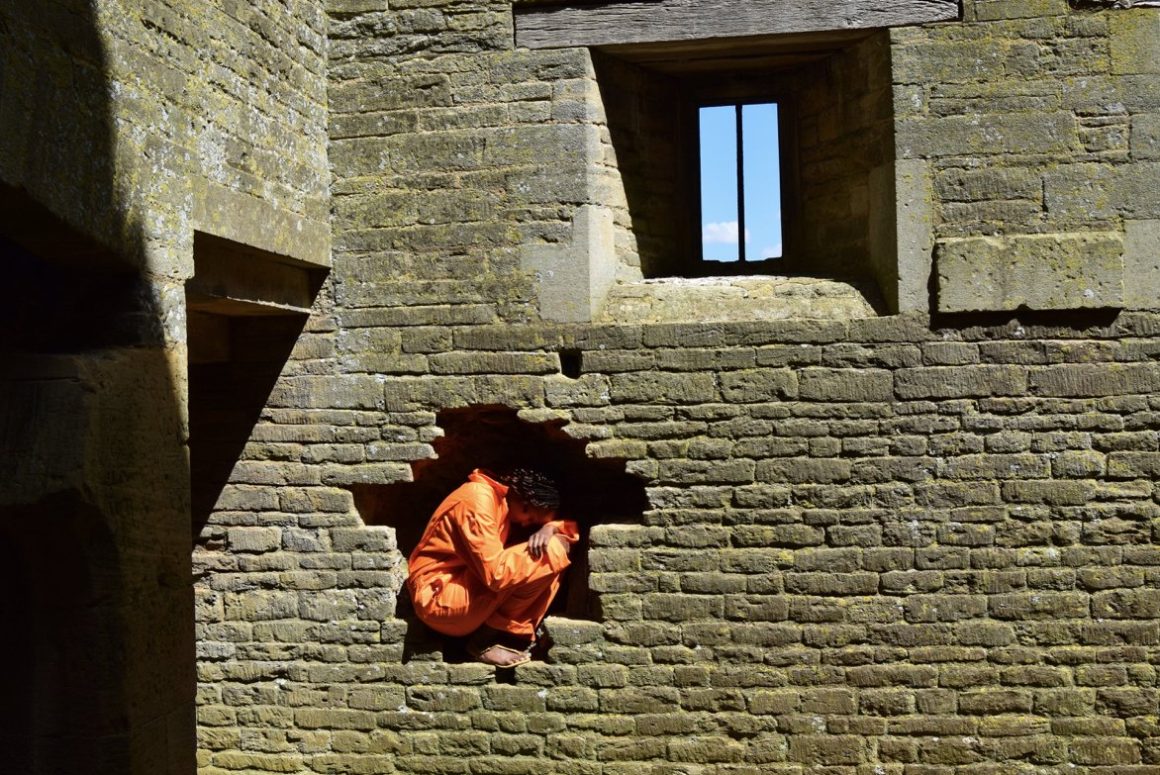
In 2021, she was commissioned by the Women’s Art Collection to respond to their exhibition, ‘Maud Sulter: The Centre of the Frame’ and she created a film and publication, Tongues, which explored fairytales, language and black girlhood In her current body of work, she is playing with words, landscape and plant-derived watercolours.
Miriam Syowia Kyambi
Miriam Kyambi is a multidisciplinary visual artist and curator based in Nairobi, Kenya. Kyambi’s work cuts across photography, video, drawing, sound, sculpture and performance installation.
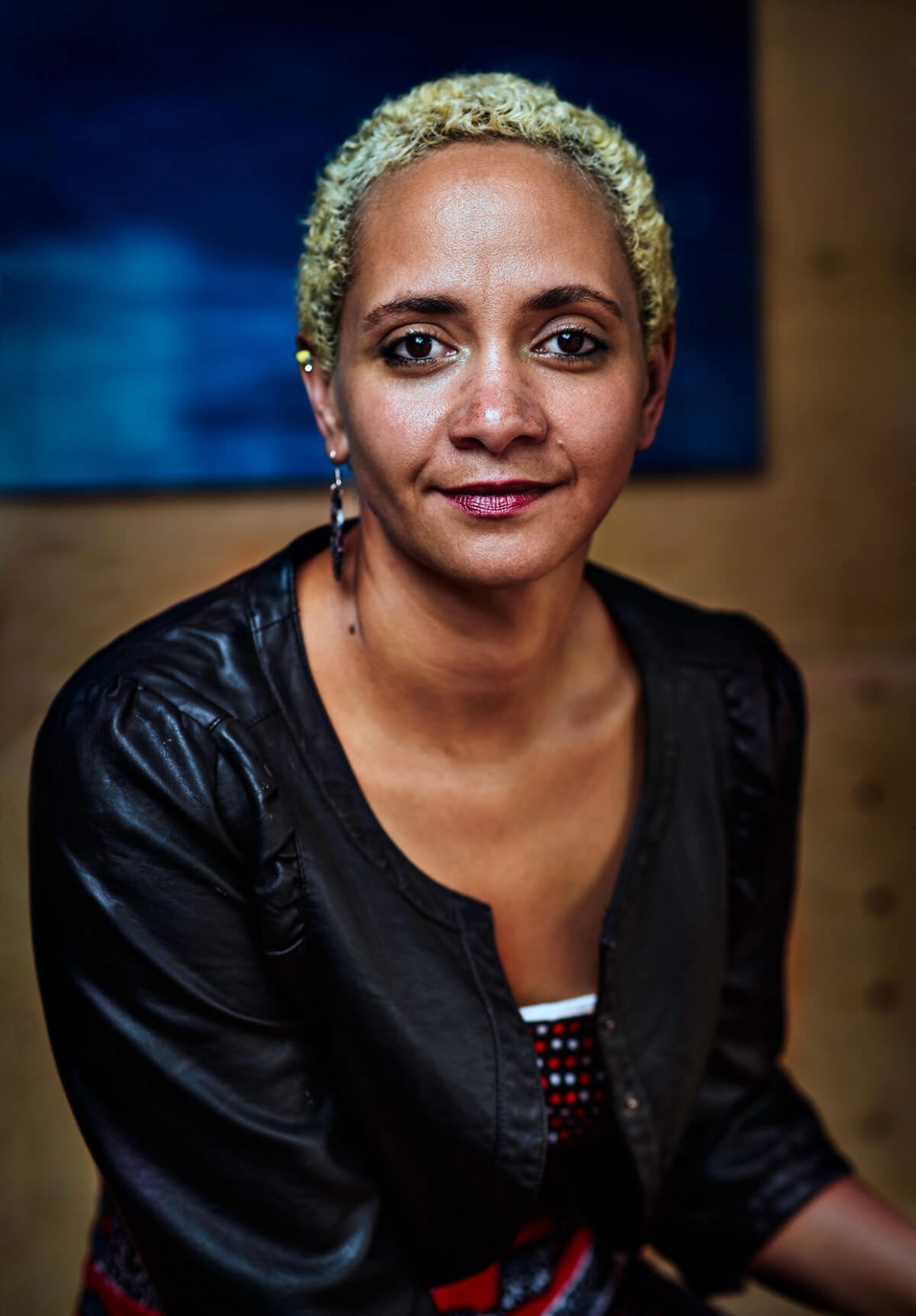
In her biographical statement, Syowia states: “… The work is messy, complex and uneasy requiring its viewers and participants to bear witness to an embodiment of collective experiences …”
Kaloki Nyamai
Kaloki Nyamai is a multidisciplinary artist who studied interior design, film and taught art classes before dedicating himself to his craft.
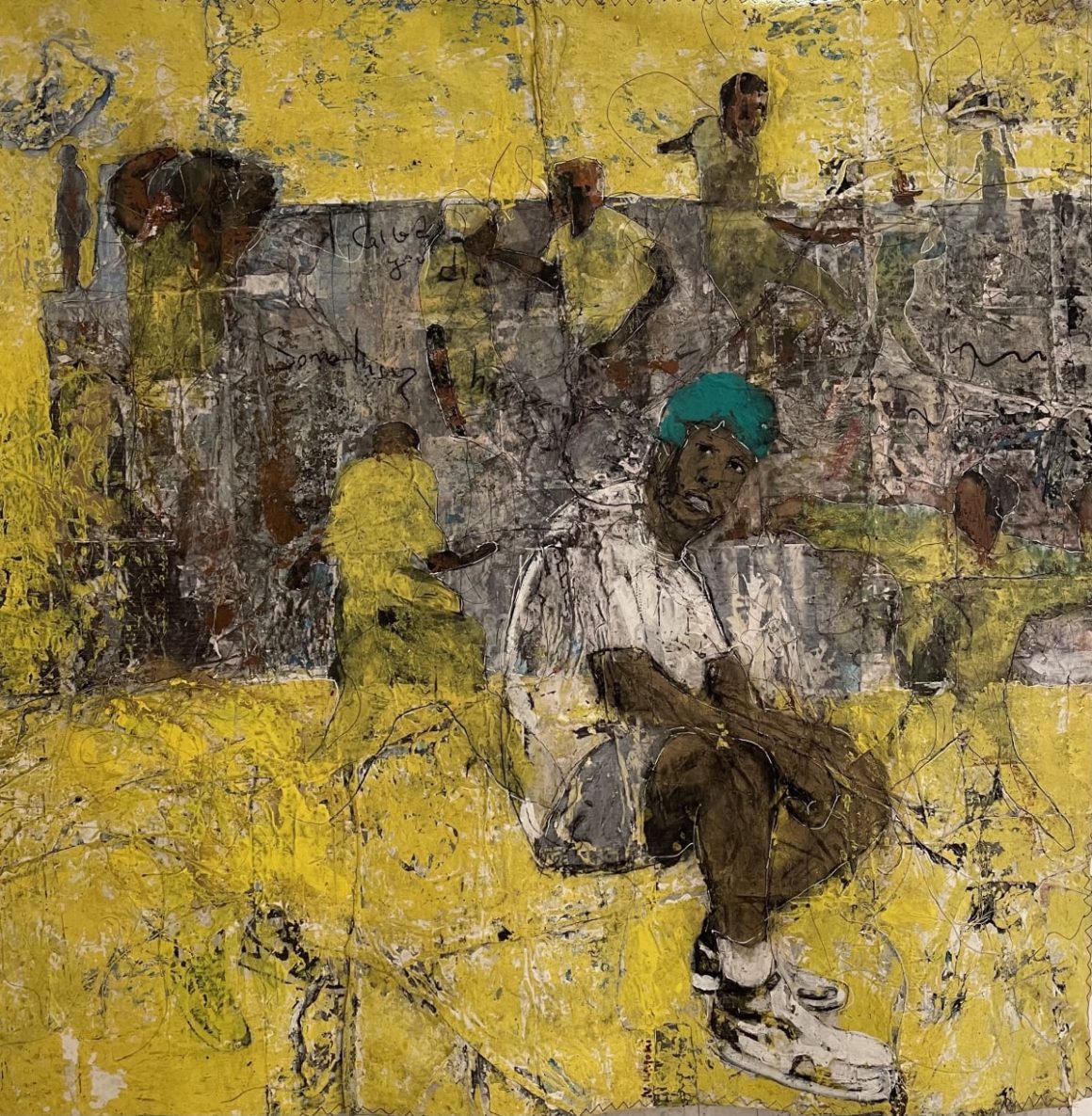
Nyamai explores how history and identity are intertwined. His works are multimedia and characterized by rich layers, offering fragments to be pieced together slowly.
If you’re in Venice, you can visit the Kenya Pavilion until November 27.
Muiruri Beautah
Muiruri Beautah is a Head Writer at WAKILISHA and a Marketing Manager at Peach Cars. He has created award winning work for brands such as Unilever, Diageo, SafeBoda and Safaricom Plc. He lives in Nairobi and in the hearts of children around the world.


